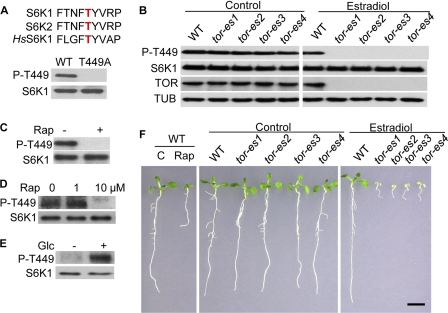FIGURE 1.
Monitor TOR activity based on Thr-449 phosphorylation of S6K1. A, conserved TOR phosphorylation of S6K proteins: conserved TOR phosphorylation motif in human and Arabidopsis S6Ks (upper) and Thr-449 phosphorylation specificity of S6K1 (lower). FLAG-tagged WT or mutant S6K1 (T449A) was transiently expressed in protoplasts. Total proteins were analyzed by protein blot analysis using anti-Thr(P)-T389 (P-T455) or anti-FLAG (S6K1) antibody. B, Thr-449 phosphorylation abolished in tor mutants. WT or estradiol-inducible tor mutants (tor-es) protoplasts expressing FLAG-tagged S6K1 were treated without or with estradiol (10 μm). Total proteins were analyzed by protein blotting probed with anti-TOR (TOR), anti-Thr(P)-389 (P-T449), or anti-FLAG (S6K1) antibody. Tubulin (TUB) was used as a loading control. C, inhibition of Thr-449 phosphorylation by rapamycin in leaf cells. WT protoplasts expressing FLAG-tagged S6K1 were treated with rapamycin (Rap, 1 μm) for 30 min. D, inhibition of Thr-449 phosphorylation by rapamycin in seedlings. Transgenic S6K1-overexpressing seedlings were treated with rapamycin (1 or 10 μm) for 30 min. E, activation of Thr-449 phosphorylation by glucose. Transgenic S6K1-overexpressing seedlings were grown with or without glucose (Glc, 30 mm) for 4 days. F, rapamycin and tor mutants retarding seedling growth. Rapamycin (10 μm) or estradiol (10 μm) was added at the time of germination for 9 days. Scale bar, 5 mm.

